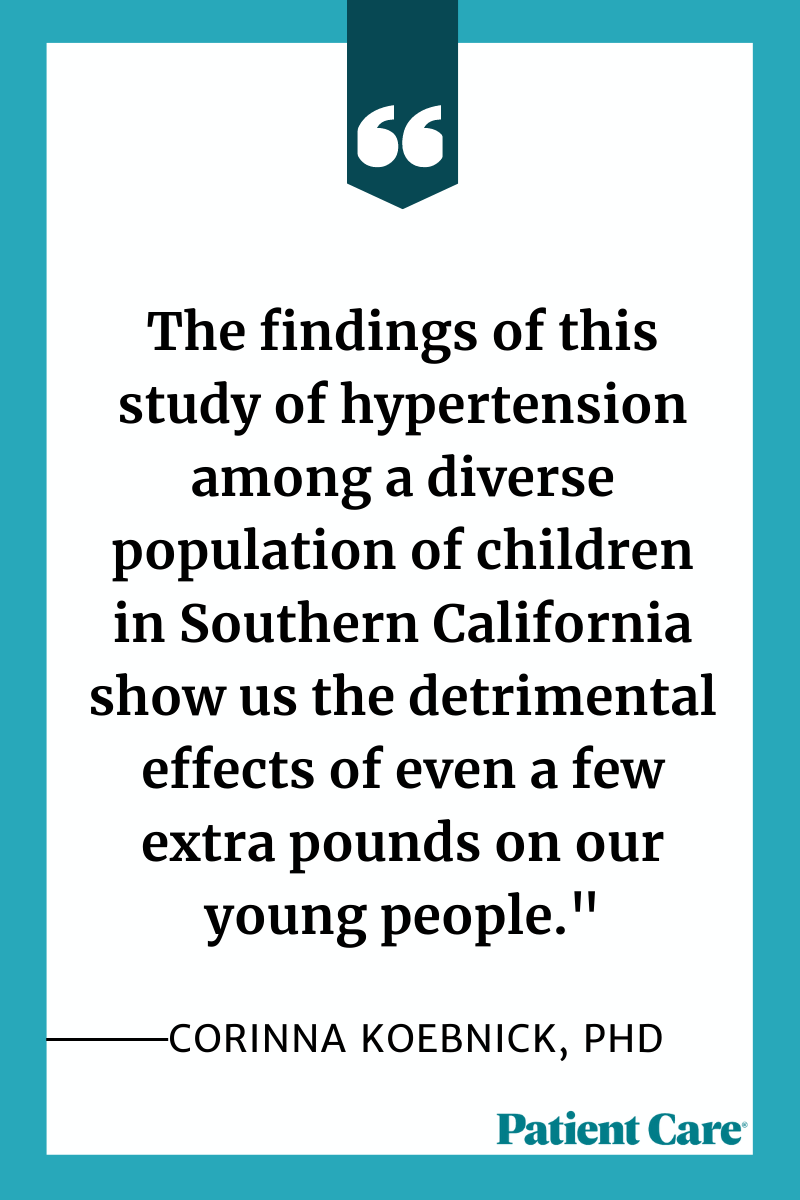- Clinical Technology
- Adult Immunization
- Hepatology
- Pediatric Immunization
- Screening
- Psychiatry
- Allergy
- Women's Health
- Cardiology
- Pediatrics
- Dermatology
- Endocrinology
- Pain Management
- Gastroenterology
- Infectious Disease
- Obesity Medicine
- Rheumatology
- Nephrology
- Neurology
- Pulmonology
Children, Adolescents with Higher BMI at Increased Risk for Hypertension, According to New Research
Youth at the upper range of normal weight had a 26% higher risk of developing hypertension than those in the lower range of normal weight, according to a new study.

Children and adolescents at the upper range of normal weight had a 26% higher risk of developing hypertension (HTN) than those in the lower range of normal weight, according to findings from a new Kaiser Permanente study of over 800 000 youth.
“Hypertension during youth tracks into adulthood and is associated with cardiac and vascular organ damage. Since the organ damage can be irreversible, preventing hypertension in our young people is critically important,” said lead author, Corinna Koebnick, PhD, of the Kaiser Permanente Southern California Department of Research & Evaluation, in a Kaiser press release. “The findings of this study of hypertension among a diverse population of children in Southern California show us the detrimental effects of even a few extra pounds on our young people.”
The study was published online March 14, 2023, in JAMA Network Open.
Koebnick and colleagues conducted a retrospective cohort study to examine the risk of HTN associated with high normal body mass index (BMI) for age and different weight trajectories in children and adolescents aged 3-17 years. Researchers analyzed the electronic health records of 801 019 youth who were members of Kaiser Permanente in Southern California between 2008 and 2015, with a follow-up of 5 years.

Using the US Centers for Disease Control and Prevention growth charts, investigators divided average BMI into low (5th-39th percentile), medium (40th-59th percentiles), and high (60th – 84th percentiles) to provide insight into the risk of HTN at a weight below the threshold for overweight. Youths were categorized as underweight (BMI for age <5th percentile), low normal weight (≥5th to <40th percentile), medium normal weight (≥40th to <60th percentiles), high normal weight (≥60th to <85th percentiles), overweight (≥85th to <95th percentiles), moderately obese (≥95th to <97th percentiles), and severely obese (≥97th percentile).
Findings
Overall, the median age of the study cohort was 9.4 years, 51.1% were girls, and 53.4% were Hispanic. Over the 5-year follow-up, researchers identified 24 969 youths with incident HTN (incidence rate [IR] 6.97 per 1000 person-years; 95% CI, 6.89-7.06). The IRs per 1000 person-years were higher among boys (8.49; 95% CI, 8.36-8.63) than girls (5.52; 95% CI, 5.42-5.63), higher among youths with a state-subsidized health plan (7.91; 95% CI, 7.72-8.11) than those without (6.70; 95% CI, 6.61-6.80), and were highest among White (7.20; 95% CI, 7.02-7.38) and Hispanic youths (7.19; 95% CI, 7.08-7.32) compared with other youths (IRs ranged from 5.71 to 6.40).
Compared with participants with a baseline BMI for age in the medium range (40th-59th percentile), the adjusted hazard ratio (aHR) for HTN within a maximum of 5 years was 1.26 (95% CI, 1.20-1.33) for youths in the high range (60th-84th percentiles) if they maintained their BMI for age. The aHR was 4.94 (95% CI, 4.72-5.18) in participants with a baseline BMI for age in the ≥97th percentile (severely obese) who maintained their body weight.
With every 1-unit annual increase in the distance to the median BMI for age, the aHR increased by 1.04 (95% CI, 1.04-1.05), according to the study results. Weight gain increased the risk associated with baseline BMI for age in the ≥97th percentile with an aHR of 1.04 (95% CI, 1.04-1.05) per 1-unit annual increase in the distance to the median BMI for age.
The risk associated with weight change was higher in youths with low to high normal weight and overweight than in youths with severe obesity, “indicating a plateau in the association between weight gain and risk of hypertension,” wrote investigators.
“Further research is needed to evaluate the wide range of body weight considered normal in youths and the health risks associated with high normal weight,” concluded researchers.
Reference: Koebnick C, Sidell MA, Li X, et al. Association of high normal body weight in youths with risk of hypertension.JAMA Netw Open. 2023;6:e231987.
Obesity Linked to Faster Alzheimer Disease Progression in Longitudinal Blood Biomarker Analysis
December 2nd 2025Biomarker trajectories over 5 years in study participants with AD show steeper rises in pTau217, NfL, and amyloid burden among those with obesity, highlighting risk factor relevance.
